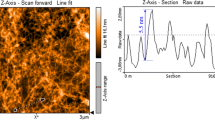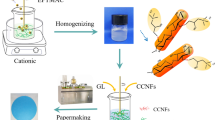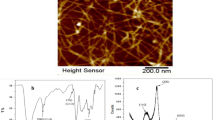Abstract
Ion-exchange fiber has been widely used as a conventional adsorbent for water purification, but its base material, the petroleum, does not comply with the current trend of environmental protection. The synthesis of functional materials from natural resources attracts intensive interest. Cotton lint fiber is a natural cellulose based hollow fiber, which has a unique advantage in ion-exchange process. Herein, for the first time, a cationic design for the cotton lint fiber was carried out in a simple two-step strategy. The cellulose based anion-exchange fiber (CAF) showed well-preserved fibrous macrostructure and cellulose nanofibril structure. And the ideal cationic group content (133.26 mmol·100 g−1) of it indicates the successful combination of structural and functional properties, which are the responsible for its excellent adsorption efficiency that includes the high adsorption capacity (above 1300 mg g−1), rapid adsorption rate (90% of its equilibrium uptake within 6 min at the initial concentration of 300 mg L−1), perfect solid/liquid separation property, and good recyclability (> 95%) for congo red. Additionally, the adsorption mechanism can be attributed to the synergistic effect of electrostatic attraction, hydrogen bonding, and van der Waals force, which was explained by the employment of classical adsorption models and advanced double layer statistical physical model. The results show that this functionalized biomaterial is an ideal candidate to replace the conventional anion-exchange fiber. This work not only revolutionizes the application of natural plant fiber, but also provides a cost-effective and simple strategy for the utilization of cellulose.










Similar content being viewed by others
Availability of data and materials
The datasets used or analysed during the current study are available from the corresponding author on reasonable request.
References
Abitbol T, Rivkin A, Cao Y, Nevo Y, Abraham E, Ben-Shalom T, Lapidot S, Shoseyov O (2016) Nanocellulose, a tiny fiber with huge applications. Curr Opin Biotech 39:76–88. https://doi.org/10.1016/j.copbio.2016.01.002
Almonaityte K, Bendoraitiene J, Babelyte M, Rosliuk D, Rutkaite R (2020) Structure and properties of cationic starches synthesized by using 3-chloro-2-hydroxypropyltrimethylammonium chloride. Int J Biol Macromol 164:2010–2017. https://doi.org/10.1016/j.ijbiomac.2020.08.089
Azubuike CP, Rodríguez H, Okhamafe AO, Rogers RD (2012) Physicochemical properties of maize cob cellulose powders reconstituted from ionic liquid solution. Cellulose 19:425–433. https://doi.org/10.1007/s10570-011-9631-y
Benjelloun M, Miyah Y, Evrendilek GA, Zerrouq F, Lairini S (2021) Recent advances in adsorption kinetic models: their application to dye types. Arab J Chem. https://doi.org/10.1016/j.arabjc.2021.103031
Cera L, Gonzalez GM, Liu Q, Choi S, Chantre CO, Lee J, Gabardi R, Choi MC, Shin K, Parker KK (2021) A bioinspired and hierarchically structured shape-memory material. Nat Mater 20(2):242–249. https://doi.org/10.1038/s41563-020-0789-2
Chen WS, Yu HP, Lee SY, Wei T, Li J (2018) Nanocellulose: a promising nanomaterial for advanced electrochemical energy storage. Chem Soc Rev 47:2837–2872. https://doi.org/10.1039/C7CS00790F
Chen H, Yu X, Wang X, He Y, Zhang C, Xue G, Liu Z, Lao H, Song H, Chen W (2021) Dyeing and finishing wastewater treatment in China: state of the art and perspective. J Clean Prod 326:129353. https://doi.org/10.1016/j.jclepro.2021.129353
Chiu HC, Liu CH, Chen SC, Suen SY (2009) Adsorptive removal of anionic dye by inorganic–organic hybrid anion-exchange membranes—ScienceDirect. J Membr Sci 337(1):282–290. https://doi.org/10.1016/j.memsci.2009.04.004
Cseri L, Topuz F, Abdulhamid MA, Alammar A, Szekely G (2021) Electrospun adsorptive nanofibrous membranes from ion exchange polymers to snare textile dyes from wastewater. Adv Mater Technol. https://doi.org/10.1002/admt.202000955
Cuissinat C, Navard P, Heinze T (2008) Swelling and dissolution of cellulose. Part IV: free floating cotton and wood fibres in ionic liquids. Carbohyd Polym 72(4):590–596. https://doi.org/10.1016/j.carbpol.2007.09.029
Das R, Sharma PR, Chi K, Hsiao BS (2022) Nanocellulose for sustainable water purification. Chem Rev 122:8936–9031. https://doi.org/10.1021/acs.chemrev.1c00683
Duan C, Meng J, Wang X, Meng X, Sun X, Xu Y, Zhao W, Ni Y (2018) Synthesis of novel cellulose-based antibacterial composites of Ag nanoparticles@ metal-organic frameworks@ carboxymethylated fibers. Carbohyd Polym 193:82–88. https://doi.org/10.1016/j.carbpol.2018.03.089
Economy J, Dominguez L (2002) Polymeric ion-exchange fibers. Ind Eng Chem Res 41(25):6436–6442. https://doi.org/10.1021/ie0204641
French AD (2014) Idealized powder diffraction patterns for cellulose polymorphs. Cellulose 21(2):885–896. https://doi.org/10.1007/s10570-013-0030-4
Freundlich HMF (1906) Over the adsorption in solution. J Phys Chem 57:385–471. https://doi.org/10.1515/zpch-1907-5723
Ghoussoub YE, Fares HM, Delgado JD, Keller LR, Schlenoff JB (2018) Antifouling ion exchange resins. ACS Appl Mater Inter 10:41747–41756. https://doi.org/10.1021/acsami.8b12865
Greluk M, Hubicki Z (2013) Effect of basicity of anion exchangers and number and positions of sulfonic groups of acid dyes on dyes adsorption on macroporous anion exchangers with styrenic polymer matrix. Chem Eng J 215–216:731–739. https://doi.org/10.1016/j.cej.2012.11.051
Gui Z, Zhu H, Gillette E, Han X, Rubloff GW, Hu L, Sang BL (2013) Natural cellulose fiber as substrate for supercapacitor. ACS Nano 7:6037–6046. https://doi.org/10.1021/nn401818t
Guo JQ, Filpponen I, Johansson LS, Mohammadi P, Latikka M, Linder MB, Ras RHA, Rojas OJ (2017) Complexes of magnetic nanoparticles with cellulose nanocrystals as regenerable, highly efficient, and selective platform for protein separation. Biomacromol 18(3):898–905. https://doi.org/10.1021/acs.biomac.6b01778
Hassan MM, Carr CM (2018) A critical review on recent advancements of the removal of reactive dyes from dyehouse effluent by ion-exchange adsorbents. Chemosphere 209:201–219. https://doi.org/10.1016/j.chemosphere.2018.06.043
Jin L, Sun Q, Xu Q, Xu Y (2015) Adsorptive removal of anionic dyes from aqueous solutions using microgel based on nanocellulose and polyvinylamine. Bioresource Technol 197:348–355. https://doi.org/10.1016/j.biortech.2015.08.093
Khalfaoui M, Baouab MHV, Gauthier R, Lamine AB (2002) Statistical physics modelling of dye adsorption on modified cotton. Adsorpt Sci Technol 20:17–31. https://doi.org/10.1260/026361702760120908
Koshani R, Eiyegbenin JE, Wang Y, van de Ven TG (2022) Synthesis and characterization of hairy aminated nanocrystalline cellulose. J Colloid Interf Sci 607:134–144. https://doi.org/10.1016/j.jcis.2021.08.172
Kramar AD, Obradović BM, Vesel A, Kuraica MM, Kostić MM (2018) Surface cleaning of raw cotton fibers with atmospheric pressure air plasma. Cellulose 25:4199–4209. https://doi.org/10.1007/s10570-018-1820-5
Langmuir I (1916) The constitution and fundamental properties of solids and liquids. Part II.-Liquids. J Franklin Inst 184(5):102–105. https://doi.org/10.1016/S0016-0032(17)90938-X
Li X, Jin X, Zhao N, Angelidaki I, Zhang Y (2017) Novel bio-electro-Fenton technology for azo dye wastewater treatment using microbial reverse-electrodialysis electrolysis cell. Bioresour Technol 228:322–329. https://doi.org/10.1016/j.biortech.2016.12.114
Li W, Mu B, Yang Y (2019) Feasibility of industrial-scale treatment of dye wastewater via bio-adsorption technology. Bioresource Technolo 277:157–170. https://doi.org/10.1016/j.biortech.2019.01.002
Li Z, Hanafy H, Zhang L, Sellaoui L, Netto MS, Oliveira ML, Seliem MK, Dotto GL, Bonilla-Petriciolet A, Li Q (2020a) Adsorption of congo red and methylene blue dyes on an ashitaba waste and a walnut shell-based activated carbon from aqueous solutions: experiments, characterization and physical interpretations. Chem Eng J 388:124263. https://doi.org/10.1016/j.cej.2020.124263
Li Z, Sellaoui L, Franco D, Netto MS, Georgin J, Dotto GL, Bajahzar A, Belmabrouk H, Bonilla-Petriciolet A, Li Q (2020b) Adsorption of hazardous dyes on functionalized multiwalled carbon nanotubes in single and binary systems: experimental study and physicochemical interpretation of the adsorption mechanism. Chem Eng J 389:124467. https://doi.org/10.1016/j.cej.2020.124467
Li CJ, Zhang YJ, Chen H, He PY, Meng Q (2022a) Development of porous and reusable geopolymer adsorbents for dye wastewater treatment. J Clean Prod 348:131278. https://doi.org/10.1016/j.jclepro.2022.131278
Li D, Zhan W, Gao X, Wang Q, Li L, Zhang J, Cai G, Zuo W, Tian Y (2022b) Aminated waste paper membrane for efficient and rapid filtration of anionic dyes and antibiotics from water. Chem Eng J 140641:40641. https://doi.org/10.1016/j.cej.2022.140641
Liu T, Butaud P, Placet V, Ouisse M (2021) Damping behavior of plant fiber composites: a review. Compos Struct 275:114392. https://doi.org/10.1016/j.compstruct.2021.114392
Mittal N, Ansari F, Krishne GV, Brouzet C, Chen P, Larsson PT, Roth SV, Lundell F, Wgberg L, Kotov NA (2018) Multiscale control of nanocellulose assembly: transferring remarkable nanoscale fibril mechanics to macroscale fibers. ACS Nano 12:6378–6388. https://doi.org/10.1021/acsnano.8b01084
Mohammed N, Han L, Islam MS, Strong MK, Tam KC (2021) Selective adsorption and separation of organic dyes using functionalized cellulose nanocrystals. Chem Eng J 417(16):129237. https://doi.org/10.1016/j.cej.2021.129237
Moigne NL, Bikard J, Navard P (2010) Rotation and contraction of native and regenerated cellulose fibers upon swelling and dissolution: the role of morphological and stress unbalances. Cellulose 17(3):507–519. https://doi.org/10.1007/s10570-009-9395-9
Nekouei RK, Pahlevani F, Assefi M, Veena SM (2019) Selective isolation of heavy metals from spent electronic waste solution by macroporous ion-exchange resins. J Hazard Mater 371:389–396. https://doi.org/10.1016/j.jhazmat.2019.03.013
Pei A, Butchosa N, Berglund LA, Zhou Q (2013) Surface quaternized cellulose nanofibrils with high water absorbency and adsorption capacity for anionic dyes. Soft Matter 9:2047–2055. https://doi.org/10.1039/C2SM27344F
Rowland SP, Howley PS (1988) Structure in “Amorphous Regions”, accessible segments of fibrils, of the cotton fiber. Text Res J 58(2):96–101. https://doi.org/10.1177/004051758805800204
Ru J, Tong CC, Chen N, Shan PJ, Zhao XK (2019) Morphological and property characteristics of surface-quaternized nanofibrillated cellulose derived from bamboo pulp. Cellulose 26(3):1683–1701. https://doi.org/10.1007/s10570-018-2146-z
Segal L, Creely J, Martin A Jr, Conrad C (1959) An empirical method for estimating the degree of crystallinity of native cellulose using the X-ray diffractometer. Text Res J 29:786–794. https://doi.org/10.1177/004051755902901003
Sellaoui L, Guedidi H, Knani S, Reinert L, Duclaux L, Lamine AB (2015) Application of statistical physics formalism to the modeling of adsorption isotherms of ibuprofen on activated carbon. Fluid Phase Equilibr 387:103–110. https://doi.org/10.1016/j.fluid.2014.12.018
Sellaoui L, Soetaredjo FE, Ismadji S, Lima ÉC, Erto A (2017) New insights into single-compound and binary adsorption of copper and lead ions on treated sea mango shell: experimental and theoretical studies. Phys Chem Chem Phys 19(38):25927–25937. https://doi.org/10.1039/C7CP03770H
Sharib A, Bonilla-Petriciolet A, Selim AQ, Mohammed EA, Seliem MK (2021) Utilizing modified weathered basalt as a novel approach in the preparation of Fe3O4 nanoparticles : Experimental and theoretical studies for crystal violet adsorption. Chem Eng J 9:106220. https://doi.org/10.1016/j.jece.2021.106220
Sim G, van de Ven TG (2015) Spherical cellulose gel particles with donut-shaped interior structures. Cellulose 22:1019–1026. https://doi.org/10.1007/s10570-015-0560-z
Sun B, Yuan Y, Li H, Li X, Zhang C, Guo F, Liu X, Wang K, Zhao XS (2019) Waste-cellulose-derived porous carbon adsorbents for methyl orange removal. Chem Eng J 371:55–63. https://doi.org/10.1016/j.cej.2019.04.031
Tang J, Song Y, Zhao F, Spinney S, Juliana DSB, Tam KC (2018) Compressible cellulose nanofibril (CNF) based aerogels produced via a bio-inspired strategy for heavy metal ion and dye removal. Carbohyd Polym 208:404–412. https://doi.org/10.1016/j.carbpol.2018.12.079
Thomas B, Raj MC, Athira KB, Rubiyah MH, Sanchez C (2018) Nanocellulose, a versatile green platform: from biosources to materials and their applications. Chem Rev 118(24):11575–11625. https://doi.org/10.1021/acs.chemrev.7b00627
Vazquez A, Foresti ML, Moran JI, Cyras VP (2015) Extraction and production of cellulose nanofibers. Handbook of Polymer Nanocomposites. Springer, Berlin, pp 81–118. https://doi.org/10.1007/978-3-642-45232-1_57
Wang J, Guo X (2020) Adsorption kinetic models: physical meanings, applications, and solving methods. J Hazard Mater 390:122156. https://doi.org/10.1016/j.jhazmat.2020.122156
Xue JM, Wang XC, Tian ED, Chang J, Wu CT (2019) Bioinspired multifunctional biomaterials with hierarchical microstructure for wound dressing. Acta Biomater 100:270–279. https://doi.org/10.1016/j.actbio.2019.10.012
Xue H, Gao X, Seliem MK, Mobarak M, Dong R, Wang X, Fu K, Li Q, Li Z (2023) Efficient adsorption of anionic azo dyes on porous heterostructured MXene/biomass activated carbon composites: experiments, characterization, and theoretical analysis via advanced statistical physics models. Chem Eng J 451:138735. https://doi.org/10.1016/j.cej.2022.138735
Yang X, Berglund LA (2020) Structural and ecofriendly holocellulose materials from wood: microscale fibers and nanoscale fibrils. Adv Mater 33:2001118. https://doi.org/10.1002/adma.202001118
Yano H, Sasaki S, Shams MI, Abe K, Date T (2014) Wood pulp-based optically transparent film: a paradigm from nanofibers to nanostructured fibers. Adv Opt Mater 2(3):231–234. https://doi.org/10.1002/adom.201300444
Yao H, Yu H, Zhang BY (2022) Approximately 1 nm-sized artificial tunnels in wrinkled graphene-graphene oxide composite membranes for efficient dye/dye separation and dye desalination. Chem Eng J 445:136753. https://doi.org/10.1016/j.cej.2022.136753
Ys A, Qh A, Ys A, Xl A, Hw A, Ling ZA, Kai JA, Cg B (2019) The feasibility of UF-RO integrated membrane system combined with coagulation/flocculation for hairwork dyeing effluent reclamation. Sci Total Environ 691:45–54. https://doi.org/10.1016/j.scitotenv.2019.07.130
Zhai Q, Liu R, Wang C, Wen X, Li X, Sun W (2022) A novel scheme for the utilization of Cu slag flotation tailings in preparing internal electrolysis materials to degrade printing and dyeing wastewater. J Hazard Mater 424:127537. https://doi.org/10.1016/j.jhazmat.2021.127537
Zhang Z, Cai S, Li Y, Wang Z, Shen Y (2020) High performances of plant fiber reinforced Composites—a new insight from hierarchical microstructures. Compos Sci Technol 194:108151. https://doi.org/10.1016/j.compscitech.2020.108151
Zheng L, Wang X, Wang X (2015) Reuse of reverse osmosis concentrate in textile and dyeing industry by combined process of persulfate oxidation and lime-soda softening. J Clean Prod 108:525–533. https://doi.org/10.1016/j.jclepro.2015.09.027
Zla B, Tak C, Mai D, Ut C (2022) A review on the treatment of dyes in printing and dyeing wastewater by plant biomass carbon. Bioresour Technol 354:127168. https://doi.org/10.1016/j.biortech.2022.127168
Acknowledgments
This work was financially supported by the Foundation (No. GZKF202131) of State Key Laboratory of Biobased Material and Green Papermaking, Qilu University of Technology, Shandong Academy of Sciences, and High-level Foreign Experts Project (GDT20186100425).
Funding
This work was financially supported by the Foundation (No. GZKF202131) of State Key Laboratory of Biobased Material and Green Papermaking, Qilu University of Technology, Shandong Academy of Sciences, and High-level Foreign Experts Project (GDT20186100425).
Author information
Authors and Affiliations
Contributions
XS: Methodology, Software, Formal analysis, Writing—Original Draft. JW: Conceptualization, Resources, Writing—Review & Editing, Supervision. XY and YW: Validation, Data Curation. WS, DX and YG: Investigation, Writing—Review & Editing. CD: Writing—Review & Editing, Data Curation.
Corresponding author
Ethics declarations
Conflict of interest
The authors have no relevant financial or non-financial interests to disclose.
Ethics approval
Not applicable.
Consent to participate
Not applicable.
Consent for publication
Not applicable.
Additional information
Publisher's Note
Springer Nature remains neutral with regard to jurisdictional claims in published maps and institutional affiliations.
Supplementary Information
Below is the link to the electronic supplementary material.
Rights and permissions
Springer Nature or its licensor (e.g. a society or other partner) holds exclusive rights to this article under a publishing agreement with the author(s) or other rightsholder(s); author self-archiving of the accepted manuscript version of this article is solely governed by the terms of such publishing agreement and applicable law.
About this article
Cite this article
Shao, X., Wang, J., Yao, X. et al. Cellulose based hierarchically structured anion-exchange fiber for efficient dye adsorption. Cellulose 31, 411–426 (2024). https://doi.org/10.1007/s10570-023-05605-x
Received:
Accepted:
Published:
Issue Date:
DOI: https://doi.org/10.1007/s10570-023-05605-x




